My easy peasy pallet planter project. Plus: lots of links, lots of aphids, and a new community feature
A jam-packed edition featuring my new approach to vertical planting, and loads more
You’re reading The Earthworm, a newsletter that takes a sideways look at the world of gardens, gardening, horticulture and all that good green stuff. If this is your first time here, you can catch up on anything you’ve missed by following this link. Subscribe now for free and join the community! You can also support me and my work on The Earthworm by upgrading to a paid subscription at any time – just tap the button below.
Is there a more upcycled item out there than the humble pallet? Scaffold boards might come close I suppose, and vintage apple crates before them. But no, I still think your classic, run-of-the-mill, off-the-forklift wooden pallet must be the most repurposed piece of paraphernalia you can get your creative claws on.
The reasons are manifold. First up, and probably most importantly, they tend to be free. This is in stark contrast to used scaffold boards or apple crates, say, which second-hand sellers and timber yards have cottoned onto the market value for.
The other reason pallets are so popular for upcycling projects is that it doesn’t take a huge amount of imagination, equipment or DIY prowess to work out how to convert them into something else. Especially in the garden. Stand a few of them upright and you can quickly create an impressive home compost heap. Lay them flat on a bit of dug-out, levelled ground and you’ve got yourself some low cost decking. And easiest of all, strategically staple some weed membrane to it and hey presto, you’ve built an upright planter.
This vertical pallet planter is a DIY job so ridiculously straightforward that even I was able to manage it. Here’s a picture of my efforts, from back in November 2020:
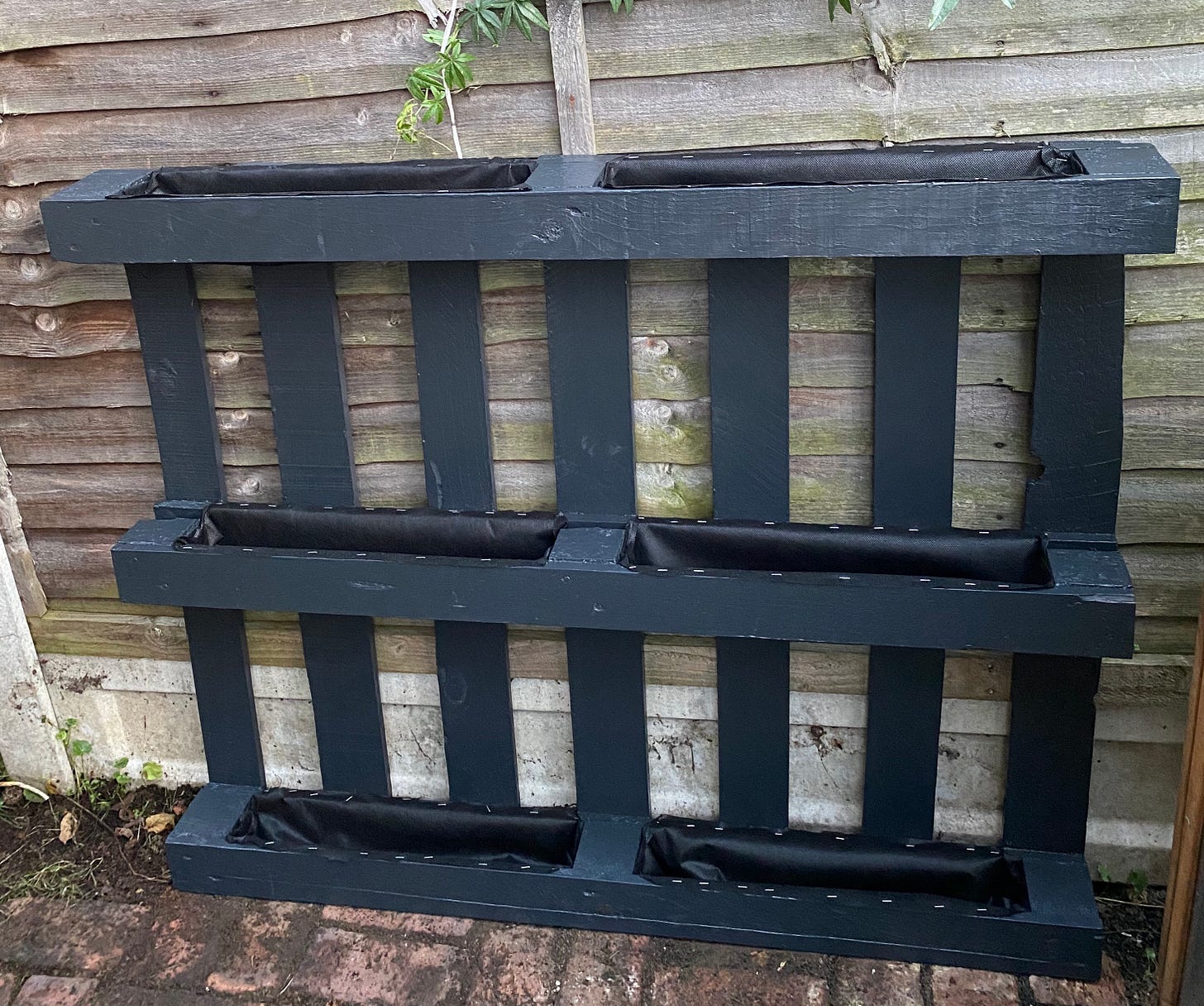
As with the majority of my garden-based endeavours, I initially made a lot of mistakes. The principal one being that I treated the pallet as basically just a three-tiered window box. The reason that was a silly thing to do – and I did at one time have the dead plants to prove it – is that in fact each half (left and right) of each shelf (top to bottom) has its own unique light conditions, ranging from quite-a-decent-amount-of-light-for-a-northish-facing-fence through to deep shade.
Also, the shelves themselves are much, much shallower than any window box, and since they are lined with highly permeable weed membrane, it means that the shelves dry out very, very quickly. In winter, this wasn’t really an issue. It was cool and wet enough to keep the ferns, ivys, cyclamens, primroses and violas alive and well. This lulled me into a false sense of security, which meant by the following summer I had a lot of very sad and shrivelled verbenas, petunias and lobelias on my hands (and eventually in the garden waste bin).
This year, I’m trying something different: alpines. If you don’t know, “alpine” is a broad category that describes plants which grow in a – you guessed it! – alpine climate. High elevation. Cold. Exposed. Rocky. The plants themselves often look very dainty and delicate, but are actually drought-tolerant and hard(y) as nails.
Below is a picture of where I’ve ended up. You’ll notice that the lowest shelf is still a bit bare – I’m probably going to plant another fern or two in there, as they have (so far!) fared fairly well in the shadier parts of the pallet.
I’ve now got my sights set on my next pallet-based upcycling project: a green roof for the shed. Watch this space… How about you? Do you have any upcycled pallets or other bits and pieces in your garden? What has – and has not – worked for you? Please do share your wisdom, failings, or both!
Attack of the killer aphids
What’s your favourite band? What’s your favourite film? What’s your favourite brand and flavour of crisps? I hate questions like these. Partly because they are often used as a lazy shorthand to identify the “kind of person” that someone might be. But mainly because I find them too difficult to answer.
So, what’s my favourite flower? Impossible to say. But I do really, really, really love an iris. Specifically, a bearded iris. Two years ago, I bought a couple of plants from the local garden centre – both Iris germanica ‘Black Knight’ – and planted them out in a sunny spot in the garden. They didn’t flower. A year passed: nothing. So this year, my hopes remained equally low.
Oh me of little faith! The other day, a single solitary spike emerged from betwixt the leaves of one of my plants. Eventually, the tip of the spike unfurled into a beautiful bearded iris of the deepest purple. I stared at it long and lovingly and then, just as I was beginning to plot our dreamy future together, it rained.
And so it came to pass that the weather was both hot and humid, aka perfect baby-making conditions for green aphids, who like it sultry. Now, I don’t know what a green aphid’s favourite flower is, but I can tell you that they really, really, really love an iris.
Oh well, there’s always next year.
By the way, I also have colossal colonies of aphids on my climbing honeysuckle, my ‘Black Lace’ elder, my roses, and probably many more plants besides. Have you noticed an exorbitant number of these pesky sap-suckers of late?
Some links you might like
It was a bumper weekend for gardening and soil-based content over at the Guardian. For starters, the money section ran a Cost of Living Crisis-proof guide to growing your own fruit and veg, featuring useful and economical tips from a whole range of experts. In the paper, this was followed by a column, written by yours truly, on the essential tools and equipment required to embark on your grow-your-own adventure. In case you missed it, you can check it out here.
There was also an interesting trends piece tracking the rising sales of drought-resistant plants; a sweet memoir piece by a sexagenarian former teacher who unknowingly followed in his father’s hedge-laying footsteps post-retirement; and a very long and very heavyweight feature by George Monbiot about the apocalypse-averting importance of looking after our soil.
Your time to shine
One of my favourite things about producing this Substack publication is how fluid I can be with the kind of content I share with you. Unlike a magazine, for example, which for all sorts of practical and traditional reasons tends to follow a very rigid structure, I can keep mixing things up.
So, in the spirit of experimentation, I’ve decided to open up this newsletter, on an ad hoc basis, to you. All of you.
When subscriber Terry got in touch to tell me that he had been to the RHS Malvern Spring Festival last weekend – his first ever garden show – I sent him some follow-up questions. Likewise, when subscriber Naomi wrote to tell me that she and her family had enjoyed their visit to Exbury Gardens, I asked her if she wouldn’t mind going into a little more detail.
You can read Terry and Naomi’s write-ups below. And if you’re plotting – or have recently returned from – a trip to a garden or show, and you’re up for sharing your experience with the wider Earthworm community, do please hit reply to this (or any) email from me, and we’ll see where we land.
A quick Q&A with Terry, from Bristol, who bought his green-fingered mum tickets to the RHS Malvern Spring Festival as a gift last Christmas
Was it your first visit to a garden or flower show? What did you expect?
It was! I was hoping to see some lovely gardens, to be informed and inspired, and to have my interest piqued in planting something. And, of course, to see Monty Don speak.
How did the experience live up to expectations?
Well, let’s start with credit where it’s due: Monty Don exceeded expectations. What a great storyteller and orator! I knew from Gardener’s World that Longmeadow was a big garden, which must keep Monty fairly busy, but the logistics and creativity required by both him and his production team was quite surprising to hear about.
Monty aside, though, I guess where my expectations weren’t met were in the gardens themselves. I mean the ones we saw were lovely, but I just felt there were too few. Maybe just over a handful? I think I was expecting a sort of Ikea-like experience, where instead of show rooms there are show gardens, each with very different designs and feels. And where you’re so filled with novel ideas of what to do with your own little space at home that it becomes a herculean effort of stamina just to make it through all the exemplars, and out to the canteen area and the Swedish meatballs (or whatever the gardening equivalent is).
I also thought that I might learn more. I’m not much of a gardener at present. My partner and I live in a flat with exactly zero garden space. I didn’t really see anything where I thought: “oh, I could do that at home!” Or, “aha, I see now, putting together plant X with plant Y works because of soil Z.” Perhaps if I knew a little more to begin with, I’d have been able to glean more just by looking at the gardens on offer, but I think with my untrained eyes a lot was just going over my head.
Other than Monty, what were your highlights?
Geums. They’re new to me. We saw these in the floral marquee. They seemed to be growing with a sort of wild abandon; like someone had cast an enchantment on them. Very pretty and mysterious looking little flowers.
Naomi, from Camberwell in South London, reflects on her family day out at Exbury Gardens whilst on a weekend away in Hampshire
Last weekend – by total happenstance – we visited Exbury Gardens on perhaps the best day of the year. The 200-acre garden nestled in the New Forest is home to an astounding range of rhododendrons and azaleas – both at their peak bloom in early May.
In the spring sunshine we explored Witcher’s Wood, our toddler hunting for bears and sticks underneath the rangy branches of towering bushes, and stumbled across Lionel de Rothschild’s acclaimed ‘azalea bowl’. The scale and depth of colour from the blossoms and the gentle elegance of the acers felt a million miles away from the Solent and scrubby heath of the Forest.
Bearing in mind that we decided to visit purely for the promise of a miniature steam engine, the beauty of the place was an unexpected blessing.
The estate is huge. Over the course of a morning we perhaps saw just over half of its features. For our next visit we’ll skip the under-staffed and oddly frustrating canteen, pack our own picnic and find a quiet spot of our own – either in the woods, on the estuary or on the pristine lawns near the Rothschild’s neoclassical manor. And I’d make sure to visit when the garden is at its best: spring for daffodils and azaleas, autumn for acers.
I’ll also mug up on the history of the estate – a brief Google reveals that Lionel recruited an army of gardeners to fulfil his vision, building a village to house them. During the Second World War his house was requisitioned by the army and was where the D-Day landings were planned. And that’s before you get to the 1,200-odd varieties of rhododendron he and his gardeners collected and developed over the years.
Thanks for reading, and to Terry and Naomi for taking the time to share their experiences with us. As always, if you feel moved to comment on any aspect of today’s edition, please do, either by hitting the button below, or by replying to the email in your inbox. I love hearing from you, and I always respond to reader correspondence.

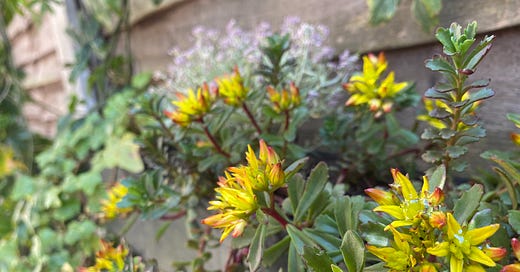



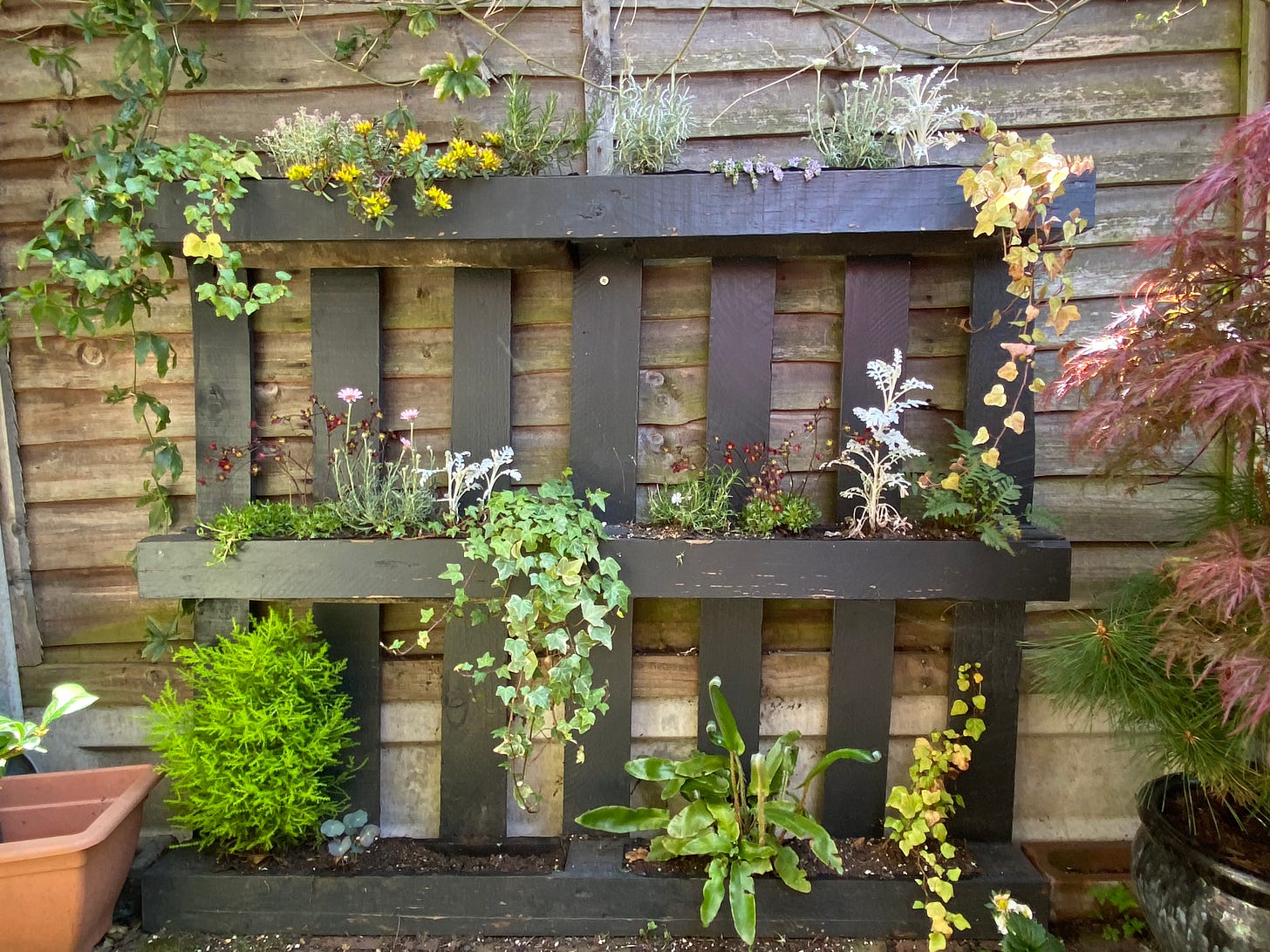

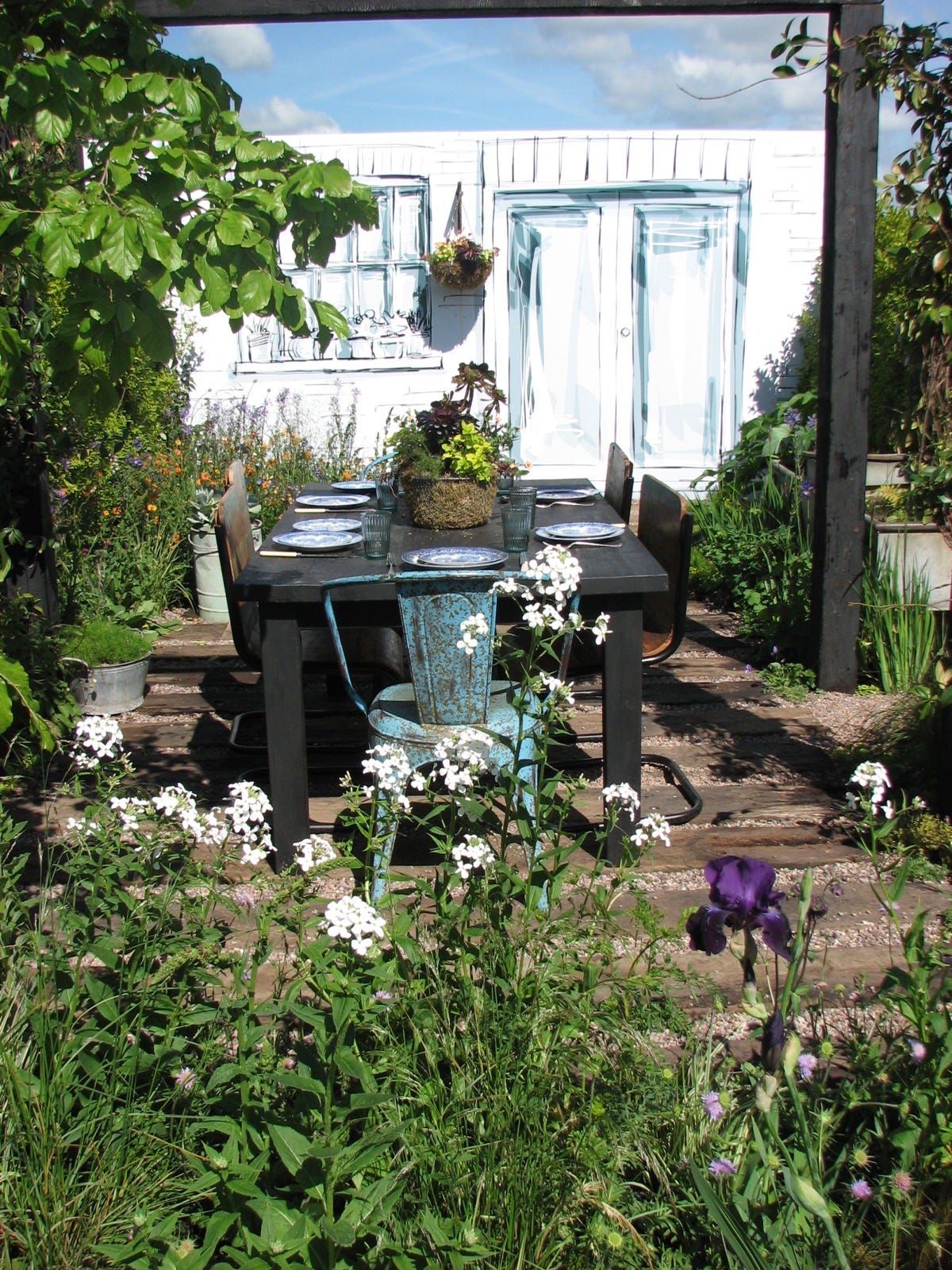
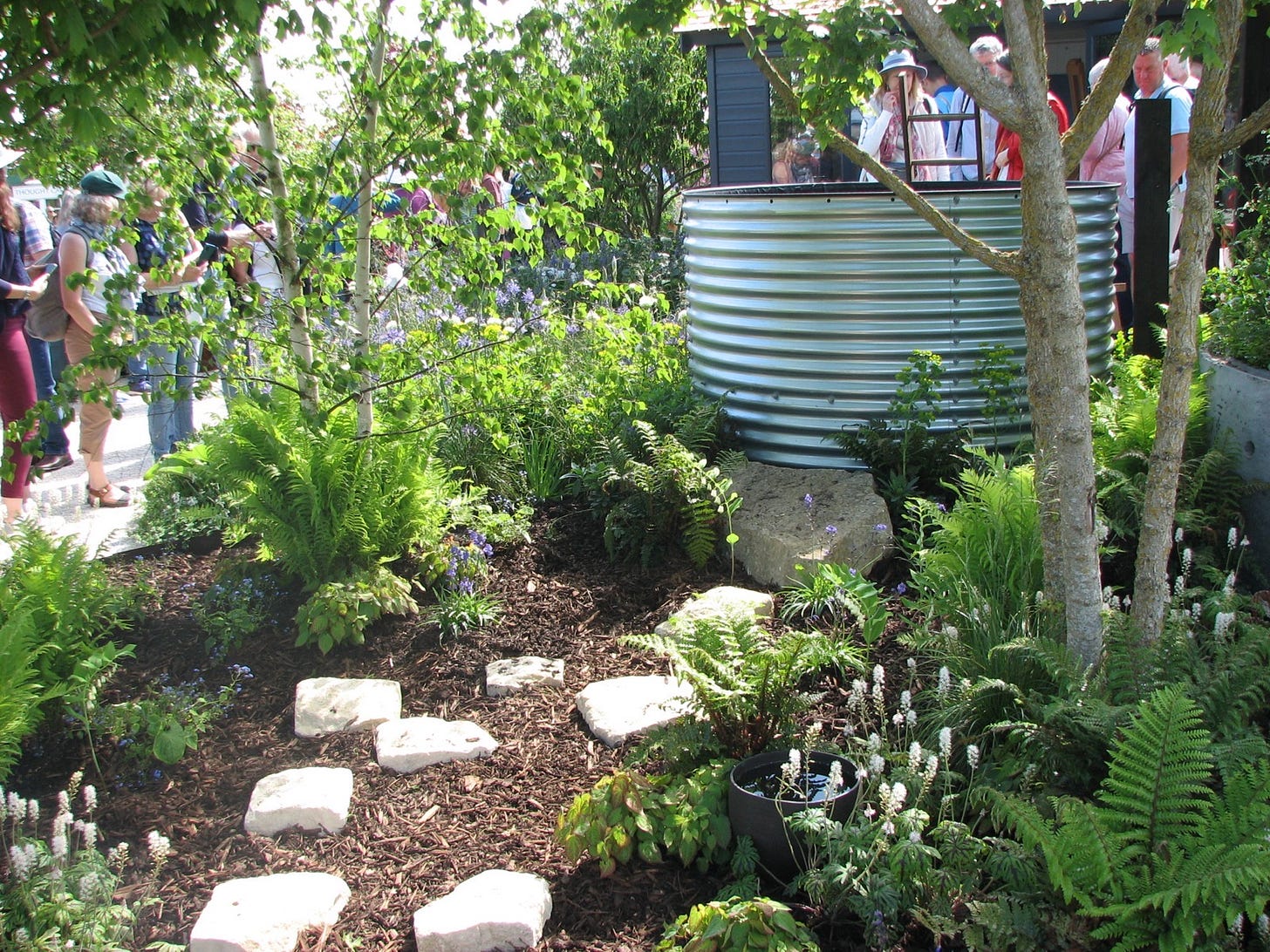

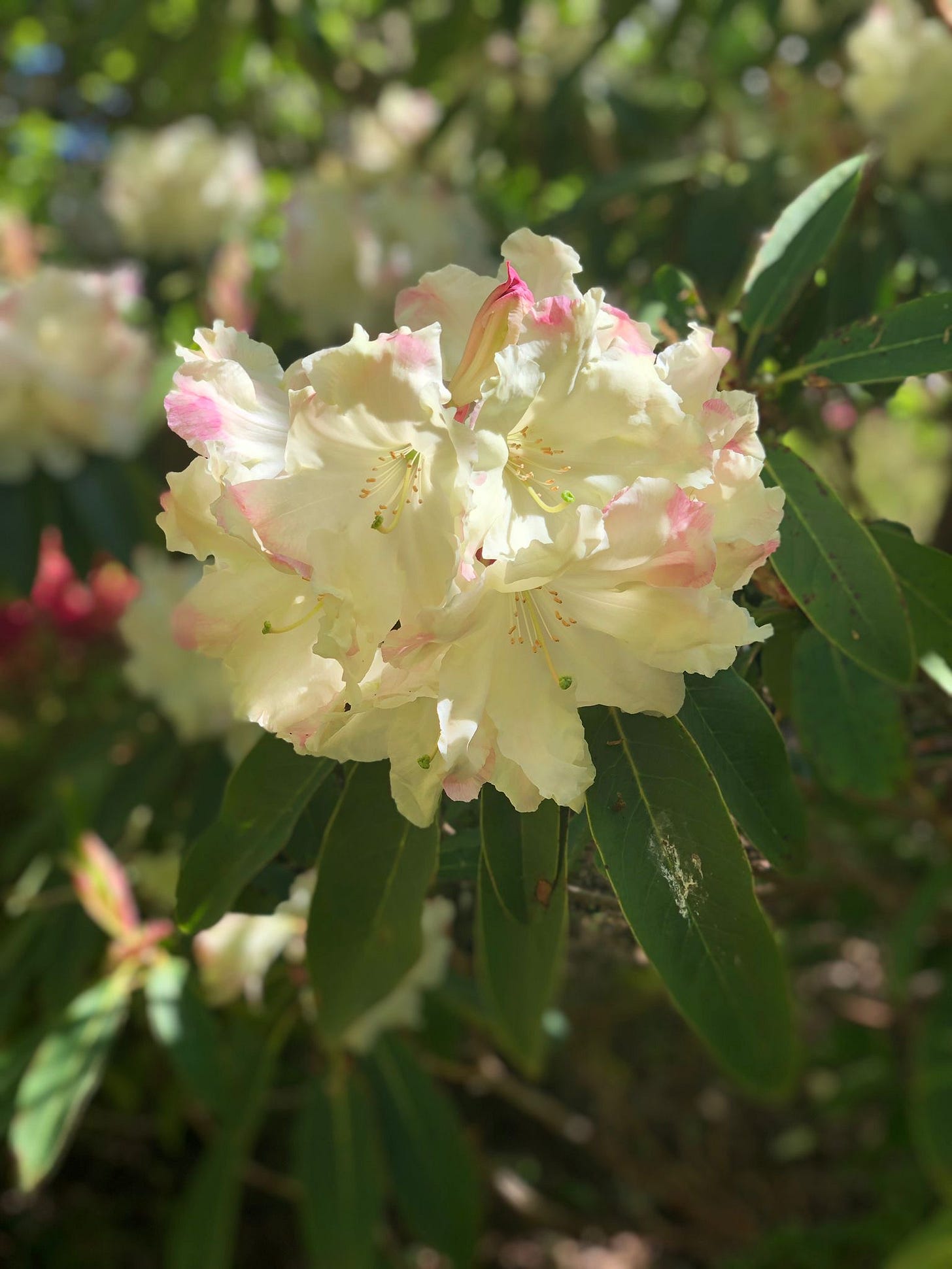
Lovely idea. Sempervivums would look fab in this display too. I've made wooden picture frames with a fine gauge wire sheet face to display my Sempervivums in. Hung on a West facing fence,like a picture.
For Terry, I went too. These are essentially trade shows, or rather trade fairs as they are selling to the public. The regional ones are, regional. It costs so much to stage the show gardens, most won't bother if there isn't sufficient return. So, the best is, im afraid, Chelsea.